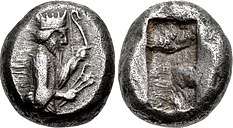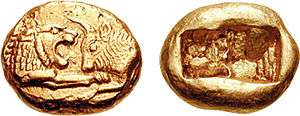Croeseid
The Croeseid, anciently Kroiseioi stateres, was a type of coin, either in gold or silver, which was minted in Sardis by the king of Lydia Croesus (561–546 BCE) from around 550 BCE. Croesus is credited with issuing the first true gold coins with a standardised purity for general circulation,[1] and the world's first bimetallic monetary system.[1]
Precedents
Before the Croesus, his father Alyattes had already started to mint various types of non-standardized coins. They were made in a natural occurring material called electrum, a variable mix of gold and silver (with about 54% gold and 44% silver), and were in use in Lydia and surrounding areas for about 80 years.[1] The unpredictability of its composition implied that it had a variable value, which greatly hampered its development.[1] The royal symbol stamped on the coin, similar to a seal, was a declaration of the value of the contents.
Herodotus mentioned the innovation made by the Lydians:[1]

"So far as we have any knowledge, they [the Lydians] were the first people to introduce the use of gold and silver coins, and the first who sold goods by retail"
— Herodotus, I94[1]
Characteristics

Croesus replaced all the electrum coins by gold and silver coins using a single coin type: the facing foreparts of a lion and a bull.[1] Compared to later copies made by the Achaemenids, the original Croeseid use a more natural rendering of the two animals.[1] The reverse was struck with two incuse squares.[1] The coins were minted in Sardis.[1] The gold and the silver were refined in Sardis from raw electrum in workshops in Sardis.[1] Recent archaeological excavations have shown stratigraphically that the first Croeseids were indeed issued by Croesus before the Achaemenid invasion, and not after the Achaemenid as has sometimes been suggested.[1][2]
The gold coins had an initial weight of 10.7 grams.[1] The silver coins also were issued in 10.7 grams, together with many smaller denominations, from 1/3 to 1/48.[1] This makes it the world's first bimetallic monetary system[1] though the idea of smaller silver denominations had originated in Cyme (Aeolis) under Hermodike II.

Soon after however, the gold coins were struck in a lighter standard of 8.1 grams.[1] The modification of the weight may have been the result of a policy to exchange and remove all electrum coins in circulation with the heavier format, the 10.7 grams corresponding to the nominal weight of gold in a standard 14.1 grams electrum stater (about 70%).[2] Once this was done the coins were lightened to 8.1 grams corresponding to the true weight of gold in the electrum coins, which had often been voluntarily debased.[2] Reducing the weight of the gold stater to 8.1 grams also allowed to simplify the exchange mechanism between gold and silver, as now 1 gold stater of 8.1 grams corresponded precisely in value to 10 silver staters of 10.7 grams, or to 20 silver coins of 5.35 grams (weight of the future Achaemenid Siglos), since the current exchange rate on a weight basis was 1 to 13.3 at the time.[1][2][3]
The great advantage of the Croeseids compared to their electrum predecessors is that they were very reliable: the pure gold and pure silver coins all had a clear intrinsic value, entirely guaranteed by their purity and clearly defined by their weight, which, as an added benefit, was standard. On the contrary, the actual composition of various electrum coins was very hard to determine, so that the true intrinsic value of each coin could not be easily estimated.[2] The royal symbol, or stamp, created by Aylettes gave the coins a declared value and today we still use a token currency, where the value is guaranteed by the state and not by the value of the metal used in the coins.[4]
Symbolism
”The lion attacking the bull motif on this coin type has been variously theorized as symbolizing the sun and moon, spring and winter (the fall of the constellation Taurus corresponded to the date of the spring sowing), strength and fertility, Asia Minor and Europe, and Lydia and its neighbor Phrygia.”[5]
Alternatively, the lion - symbol of Lydia - and the bull - symbol of Hellenic Zeus[6] (from the Seduction of Europa[7]) - are facing each other in truce; Note that hunting lions attack from the rear, also imagery of a predator and prey lying down together in peace is reflected in other ancient literature, e.g. "...the calf and the lion and the yearling together..." c.700BC[8]. In the historical context of Lydia’s alliance with Agamemnon of Cyme, an arrangement sealed by the marriage of Greek Hermodike II, possibly Croesus’ mother, to his father, Alyettes (AKA a later Midas). However, any peace between Lydians and Greeks is not to be confused with Croesus’ attempted conquest of Miletus. Notwithstanding, the croeseid symbolism of peace between the Greeks of Asia Minor, Lydians and later Persians persisted long after Croesus’ death - until Darius the Great introduced new coins c.500BC.
Achaemenid Croeseids

When the Achaemenid Empire ruler Cyrus the Great invaded Lydia, together with the rest of Asia Minor, he adopted the bimetallic system initially introduced by Croesus, and continued to strike gold and silver coins at Sardis according to the model of the Croeseid until around 520 BCE.[9] The design of the animals though was more rigid, less natural, than the original Lydian issues.[1]
These coins were found in very fresh condition in the Apadana hoard, coins deposited under the foundation stone of the Apadana in Persepolis, dated to circa 515 BCE, confirming that they had been recently minted under Achaemenid rule. The deposit did not have any Daric and Sigloi, which also suggests strongly that these Achaemenid coins only started to be minted later, after the foundation of the Apadana Palace.[10]
Replacement of the Croeseids by Achaemenid coinage
.jpg)

Under Darius I, the minting of Croesid in Sardis was then replaced by the minting of Darics and Sigloi, probably around 515 BCE. The earliest gold coin of the Achaemenid Empire, the Daric, followed the weight standard of the Croeseid, and is therefore considered to be later and derived from the Croeseid.[12] The weight of the Daric would then be modified through a metrological reform, probably under Darius I.[12]
Sardis remained the central mint for the Persian Darics and Sigloi of Achaemenid coinage, and there is no evidence of other mints for the new Achaemenid coins during the whole time of the Achaemenid Empire.[13] Although the gold Daric became an international currency which was found throughout the Ancient world, the circulation of the silver Sigloi remained very much limited to Asia Minor: important hoards of Sigloi are only found in these areas, and finds of Sigloi beyond are always very limited and marginal compared to Greek coins, even in Achaemenid territories.[13]
References
- Metcalf, William E. (2016). The Oxford Handbook of Greek and Roman Coinage. Oxford University Press. pp. 49–50. ISBN 9780199372188.
- Cahill, Nick; Kroll, John H. New archaic coin finds at Sardis, AJA 109 (2005). pp. 609–614.
- Fisher, William Bayne; Gershevitch, I.; Boyle, John Andrew; Yarshater, Ehsan; Frye, Richard Nelson (1968). The Cambridge History of Iran. Cambridge University Press. pp. 616–617. ISBN 9780521200912.
- Amelia Dowler, Curator, British Museum; A History of the World; http://www.bbc.co.uk/ahistoryoftheworld/objects/7cEz771FSeOLptGIElaquA
- http://rg.ancients.info/lion/kroisos.html
- Perseus 1:2.7 - http://data.perseus.org/citations/urn:cts:greekLit:tlg0548.tlg001.perseus-eng1:2.7 - [Hercules] had Agelaus, from whom the family of Croesus was descended."
- 1912-1996., Grimal, Pierre, (1991). The Penguin dictionary of classical mythology. Kershaw, Stephen. ([Abridged ed.] ed.). London, England: Penguin Books. ISBN 0140512357. OCLC 25246340.
- Isaiah 11:6 The wolf will live with the lamb, the leopard will lie down with the goat, the calf and the lion and the yearling together; and a little child will lead them.
- Metcalf, William E. (2016). The Oxford Handbook of Greek and Roman Coinage. Oxford University Press. p. 51. ISBN 9780199372188.
- Fisher, William Bayne; Gershevitch, I.; Boyle, John Andrew; Yarshater, Ehsan; Frye, Richard Nelson (1968). The Cambridge History of Iran. Cambridge University Press. p. 617. ISBN 9780521200912.
- DARIC – Encyclopaedia Iranica.
- Fisher, William Bayne; Gershevitch, I.; Boyle, John Andrew; Yarshater, Ehsan; Frye, Richard Nelson (1968). The Cambridge History of Iran. Cambridge University Press. p. 617. ISBN 9780521200912.
- Fisher, William Bayne; Gershevitch, I.; Boyle, John Andrew; Yarshater, Ehsan; Frye, Richard Nelson (1968). The Cambridge History of Iran. Cambridge University Press. p. 619. ISBN 9780521200912.
._Heavy_series._Sardes_mint.jpg)

._Heavy_series._Sardes_mint.jpg)
